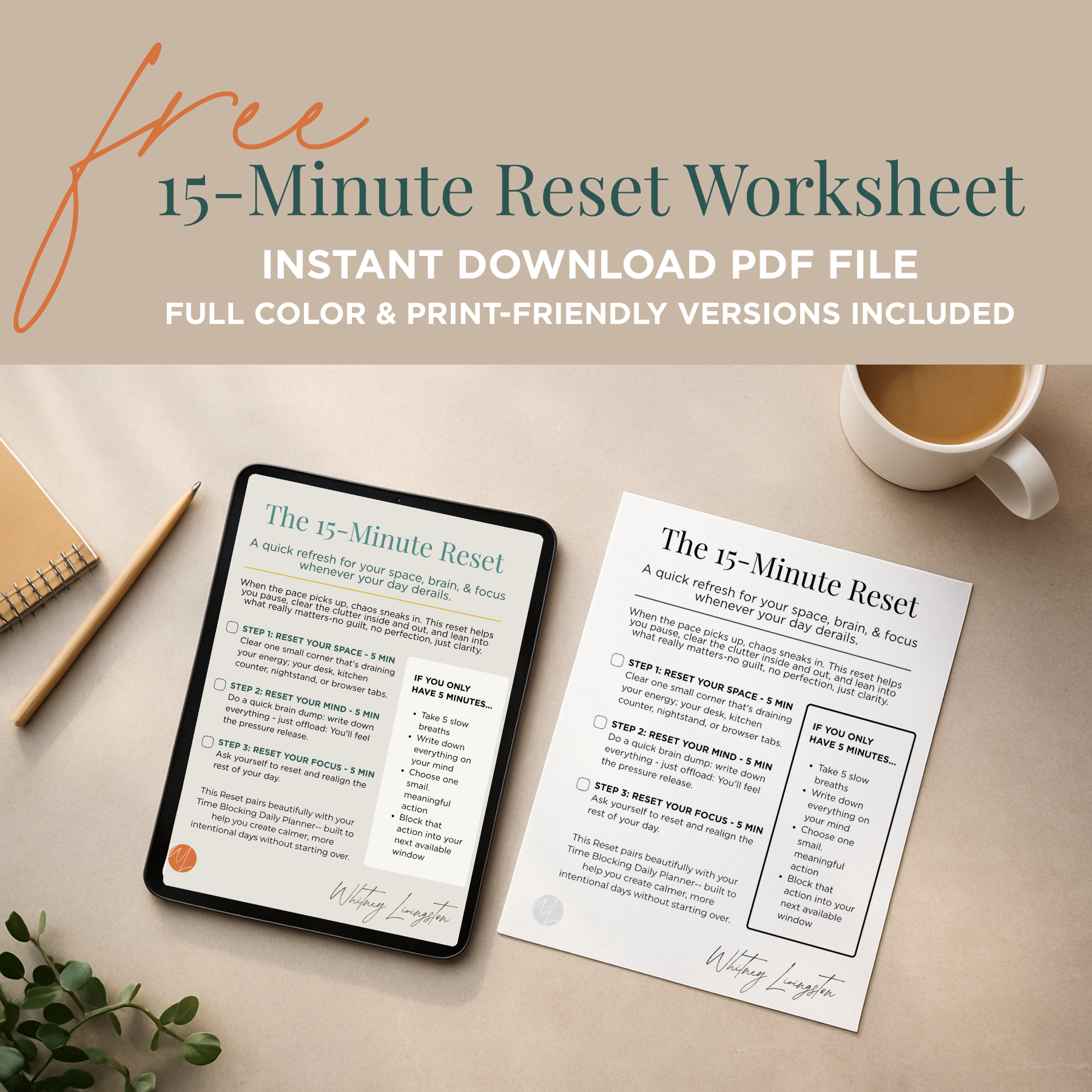The 15-Minute Reset
How to Get Your Day (and Energy) Back on Track
You know that feeling when the day starts running you instead of the other way around?
The emails, the notifications, the mess on the counter that somehow multiplies before lunch… and suddenly, it’s 2:00 p.m. and you’re wondering what happened to your morning.
Here’s the thing: most days don’t go off the rails because of one big decision. They slip away in a series of tiny, unintentional moments.
That’s where the 15-Minute Reset comes in: a short, intentional block of time where you step out of autopilot and check back in with yourself and your priorities.
It’s not a break in the “scroll your phone and pretend to rest” kind of way. It’s a micro reset — a structured pause that clears the noise so you can reorient your focus.
Think of it like hitting “refresh” on your mindset, space, and schedule.
The purpose: not to do more, but to start fresh, anytime, mid-day, mid-week, or mid-chaos.
Why It Works
Because clarity needs margin.
When you move from task to task without pause, your mind gets cluttered, even if your to-do list is technically under control.
The 15-Minute Reset works because it interrupts that pattern of overwhelm and helps you return to intentional action. It also gives your brain what it craves most: a moment of closure.
When you tidy a surface, brain-dump your thoughts, or reset your focus, you send a signal that says, “We’re back in charge.”
That single cue can shift your entire day.
How to Do a 15-Minute Reset
Here’s the structure I use (and teach inside the Timeblock Planner):
Step 1: Reset Your Space (5 minutes)
Clear one small area that’s distracting you — your desk, kitchen counter, or desktop tabs.
Physical clutter quietly drains mental energy.
Step 2: Reset Your Mind (5 minutes)
Brain dump your current thoughts, tasks, or worries onto paper (or your Notion dashboard).
Don’t organize yet — just unload.
Then take one slow breath per line before you move on.
Step 3: Reset Your Focus (5 minutes)
Ask yourself:
→ What actually matters most for the rest of today?
→ What can wait until tomorrow?
→ What will make me feel proud if it’s the only thing I finish?
Then, rebuild your next timeblock around that.
You don’t need to scrap your whole plan — you just need to realign it.
When to Use It
Want this in a worksheet format? I made you two.
Get yours here.
The 15-Minute Reset is most powerful when:
You feel scattered or overstimulated
You’re switching between roles or tasks
You’ve hit an afternoon energy dip
You’re procrastinating because you don’t know where to start
Instead of pushing harder, pause and reset.
It’s amazing how much traction you can regain in a single intentional quarter-hour.
The Bigger Picture
Here’s what I remind my clients:
Most productivity issues aren’t time problems — they’re clarity problems.
You don’t need more hours in your day; you need more presence in the ones you already have.
And when you practice resetting regularly, you stop waiting for a new week or month to “start fresh.” You create that feeling of clarity on demand.
So just remember…
You can’t control every distraction, detour, or delay that comes your way.
But you can control how long you stay disconnected from your focus.
That’s the power of the 15-Minute Reset. It’s not about perfection; it’s about recovery. Because when you learn to reset quickly, your days start feeling lighter, your focus lasts longer, and your time finally starts working for you again.
If you love the idea of a structured, sustainable rhythm that helps you reset before things spiral, you’ll love the Timeblock Planner.
It’s designed around micro-moments like this — helping you stay grounded, organized, and in control of your days (without burning out your brain in the process).



